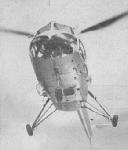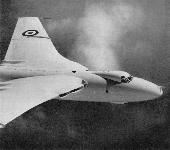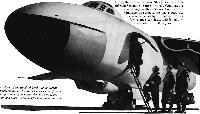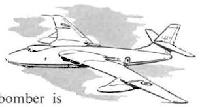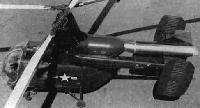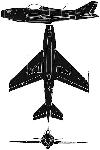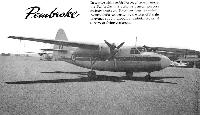Фотографии
-
Регистрационный номер: AS-101 The first French-built Fouga Magister was recently delivered to the Luftwaffe.
Самолёты на фотографии: Fouga CM.170 Magister - Франция - 1952
-
SHORT CIRCUITS & BUMPS. Taking the prize for the "Dak with the mostest" is this U.S. Navy Douglas R4D-6Q (Q for Electronic Devices) utilised as a flying classroom for Radar Observer training. Note the thimble-nose radome, two ventral radomes and the just-visible dorsal radome immediately behind the cockpit. Under each wing (starboard carrier shown) may be mounted an additional radar pack. Just forward of the tailplane is the coding FAETULANT.
Самолёты на фотографии: Douglas DC-3 / C-47 Skytrain/С-53 Skytrooper / Dakota - США - 1935
-
Регистрационный номер: NZ6001 "Deep-Freeze" aircraft are in the news and these photographs, Auster and Beaver (photo), come from reader D. P. Woodhall, of New Zealand.
Самолёты на фотографии: De Havilland Canada DHC-2 Beaver - Канада - 1947
-
The first Dutch Armstrong Whitworth Sea Hawk in Royal Netherlands Navy insignia was F-50, which is seen during a check flight from Bitteswell prior to delivery on July 19, 1957.
Самолёты на фотографии: Hawker Sea Hawk - Великобритания - 1947
-
According to Japanese reports this drawing depicts the North American F-100J, which may be built under licence in Japan. Note the F-86D type radar on the intake.
Самолёты на фотографии: North American F-100 Super Sabre - США - 1953
-
Регистрационный номер: G-APBX The Expediter, G-APBX, in its smart blue-and-silver livery, has now returned to Hurn, home base of its owners, Independent Air Travel Ltd.
Самолёты на фотографии: Beechcraft Model 18 / C-45 Expeditor - США - 1937
-
Регистрационный номер: CF-IKO American owned and crewed and Canadian registered is this converted PBY-5A, which is operated by the Hycon Aerial Surveys Company of California, U.S.A.
Самолёты на фотографии: Consolidated PBY Catalina - США - 1935
-
Sycamore - in service throughout the world and in quantity production
Самолёты на фотографии: Bristol Sycamore / Type 171 - Великобритания - 1947
-
Rare bird is this Siskin Mk. IIIA of the R.C.A.F. According to Mr. Stone, this aircraft was one of eight serving as trainers.
Самолёты на фотографии: Armstrong Whitworth Siskin - Великобритания - 1921
-
Регистрационный номер: XA847 THE ENGLISH ELECTRIC P.1B ordered for the Royal Air Force is powered by ROLLS-ROYCE AVON TURBO JETS
Banked view of the P.1B reveals modified main-wheel doors and basic similarity of planform to P.1A.Самолёты на фотографии: English Electric / BAC Lightning - Великобритания - 1957
-
Регистрационный номер: G-AOVB Livery borne by the second Britannia 312, G-AOVB are becoming increasingly familiar.
Самолёты на фотографии: Bristol Britannia / Type 175 - Великобритания - 1952
-
Bristol Orion - world's first supercharged turboprop engine. Full take-off power to 15,000 feet
Самолёты на фотографии: Bristol Britannia / Type 175 - Великобритания - 1952
-
Britannia 310 series - long-range version ordered for world-wide service.
Самолёты на фотографии: Bristol Britannia / Type 175 - Великобритания - 1952
-
One of the two G.E.C. equipped galleys in the B.O.A.C. Britannia
Самолёты на фотографии: Bristol Britannia / Type 175 - Великобритания - 1952
-
Регистрационный номер: EC-AMR Convair 440 Metropolitans of many nationalities now grace the tarmac at British airports, among the latest being EC-AMR to 'MV of the Spanish airline Iberia.
Самолёты на фотографии: Convair CV-240 Convair-Liner / C-131 / C-340 / C-440 - США - 1946
-
Powered by four Rolls-Royce Avon engines, this medium bomber is now in full squadron service with the Royal Air Force.
Самолёты на фотографии: Vickers Valiant - Великобритания - 1951
-
The advent of the stand-off bomb (air-to-ground missile, for despatch several hundred miles from a target) actually enhances the vital role of the Valiant and other V-bombers for many years to come.
Самолёты на фотографии: Vickers Valiant - Великобритания - 1951
-
Самолёты на фотографии: Vickers Valiant - Великобритания - 1951
-
Регистрационный номер: G-AOAC Her last hand hold gone, parachuting instructress Sue Burges calmly counts off the seconds before pulling her ripcord. Between her and the ground, which is only 13 seconds away, is a G.Q. Blank-Gore steerable parachute - internationally acknowledged to be the finest equipment of its type in the world.
Самолёты на фотографии: De Havilland Tiger Moth / D.H.82 - Великобритания - 1931
-
Регистрационный номер: A17-84 The Navy's Tiger Tug at the Lasham Gliding Championships, serial A17-84
Самолёты на фотографии: De Havilland Tiger Moth / D.H.82 - Великобритания - 1931
-
Регистрационный номер: VH-AAF Waco EGC-8, VH-AAF (c/n. 5051), was delivered new to Australia in 1938, and today this large five-seat biplane (Wright Whirlwind R760E-2), in green, black and gold colour scheme, still flies at Bankstown, owned by G. B. S. Falkiner.
Самолёты на фотографии: WACO C / S Series - США - 1931
-
Регистрационный номер: ST-AAD, G-AJOS, SN-AAD Sudan nationality marks have now been changed from SN to ST, and the Sudan Airways Dove, ST-AAD (c/n. 04036, ex SN-AAD, ex G-AJOS), is an early example. It passed through Blackbushe en route to Lasham for overhaul during the month.
Самолёты на фотографии: De Havilland Dove / D.H.104 - Великобритания - 1945
-
Регистрационный номер: ET-T-12, N2047A C-82 Packet, ET-T-12 "Ontos" (ex 44-57814, ex N2047A), fitted with a Fairchild J-44 turbojet, was used to fly spares to the T.W.A. Lockheed 1049G stranded at Southend. This Ethiopian registration was formerly carried by Dakota 4 (c/n. 20874, ex 43-16409), which returned to the U.S.A. as N51179 (T.W.A. No. 203).
Самолёты на фотографии: Fairchild C-82 Packet - США - 1944
-
The Kaman HOK-1 now has an extended exhaust stack fitted to its Lycoming T-53 shaft turbine engine.
Самолёты на фотографии: Kaman H-43B / HH-43F Huskie - США - 1958Kaman HTK / HOK / HUK / H-43A Huskie - США - 1951
-
Prestwick, is the camera-ship used during the air sequences in many famous aviation films.
Самолёты на фотографии: North American B-25J Mitchell / PBJ-1G - США - 1943
-
Jet Provost. The only jet trainer in the world to have been accepted for ab initio and basic military flying training, the Jet Provost has been ordered into production for the Royal Air Force.
Самолёты на фотографии: Hunting Percival Jet Provost / P.84 - Великобритания - 1954
-
AERFER SAGITTARIO II. The Aerfer Sagittario II has a rather complicated history, which began in 1953 when Ing. Sergio Stefanutti designed and Ambrosini constructed the Sagittario I, an experimental research aircraft to provide data for a projected transonic jet fighter known as the Vindex. The Sagittario I was basically the fuselage of the S.A.I.7 piston-engined two-seat trainer, plus a new 45-degree swept-wing and swept tail surfaces. With the piston engine replaced by an 836 lb. thrust Turbomeca Marbore II turbojet, a speed of Mach 1.05 was claimed for this aircraft, which is doubtful in view of the limitations imposed by the wooden structure. It was intended to build further prototypes of all-metal construction, but the Vindex project was abandoned and the manufacturers began to consider the Sagittario design for the light fighter role. A 3,600-lb. Rolls-Royce Derwent 9 turbojet was selected and design work started on a redesigned aircraft known as the Sagittario II. At this stage the design was taken over by the Aerfer concern and the project renamed Ariete. A contract worth §1.3 million has been placed by the U.S. and Italian Governments with Aerfer for the Ariete lightweight fighter-bomber, designed to meet the N.A.T.O. specification for this class of aircraft. Three prototypes of the Ariete are on order, and it is essentially similar to the Sagittario II, but will have the Derwent 9 plus a single 1,180-lb. thrust Rolls-Royce Soar turbojet for take-off, climb and combat. Proposed armament will consist of two 30-mm. cannon, plus various underwing ordnance loads. The Sagittario II, now serving as a prototype for the Ariete now under construction, can attain Mach 1.1 in a dive and climb to 40,000 ft. in ten minutes.
Самолёты на фотографии: Ambrosini Sagittario / Ariete - Италия - 1953
-
Регистрационный номер: VH-ACD, G-AJPT The lengthened nose of renamed Auster J-2 Super Arrow, VH-ACD (c/n. 2390, ex G-AJPT), houses a Continental flat-six motor fitted by owner C. G. Henderson at Archerfield, Brisbane. Top speed goes up by 23 m.p.h., but fuel consumption is double.
Самолёты на фотографии: Auster J/1 - J/5 - Великобритания - 1945
-
Регистрационный номер: G-41-1, G-ATEL Самолёты на фотографии: Aviation Traders ATL.90 Accountant - Великобритания - 1957
-
ATL 90 ACCOUNTANT. First flight of the Aviation Traders' Accountant prototype took place from Southend Airport on 9th July, and it was a long awaited moment for "Spotters" and registration enthusiasts. Apart from the high setting of the nacelles for the Rolls-Royce Dart turboprop engines, the Accountant is an orthodox, twin-engined passenger/executive aircraft in the Fokker Friendship class. The prototype is to be fitted out as a twenty-eight-seater with four-abreast seating, which can readily be replaced by an executive layout having two three-seat settees, in addition to eight passenger seats. It is also convertible to a freighter or combined passenger/freighter. A later version known as the ATL 91 Accountant, Mk. II, has been planned and will have accommodation for forty passengers for short-haul operations. Fuselage of this version will be stretched by 10 ft. The prototype fuselage is built on the tension-skin method of construction pioneered by Aviation Traders. This will not be continued in subsequent aircraft, and two pre-production aircraft now under construction will have fuselages with a flush-riveted skin over conventional frames and stringers. The distinctive "kink" aft of the pilot's cockpit will also disappear into a smooth contour. The steerable forward-retracting nosewheel gear protrudes slightly in the retracted position and should protect the nose if a wheels-up landing has to be made.
Salient features: A twin-engined low-wing single fin and rudder passenger and freight aircraft with distinctive engine nacelles mounted high on the wing. From the side view the massive fin dominates the fuselage with its large strakes on the leading and trailing edges.Самолёты на фотографии: Aviation Traders ATL.90 Accountant - Великобритания - 1957
-
Vickers Supermarine N.113 - The Scimitar
Самолёты на фотографии: Supermarine Scimitar - Великобритания - 1956
-
The Brantly B-2 in its latest configuration in which the tail rotor has been elevated on an arm as opposed to the fuselage fitted rotor on the first prototype. Also new is the skid-type under-carriage and the square window just aft of the first circular window. Note the drooping main rotor blades.
Самолёты на фотографии: Brantly B-2 - США - 1953
-
The Breguet 1001 Taon which took to the air for the first time on 26th July. Otherwise similar to the twin Turbomeca Gazibo-powered Breguet 1100, the Taon is powered by a Bristol Orpheus turbojet.
Самолёты на фотографии: Breguet Br.1001 Taon / Br.1100 - Франция - 1957
-
Регистрационный номер: G-ANVP, N340EL First of the 41 leading airlines operating Convairliners to discard piston engines for turboprops is REAL S.A. of Brazil - seventh largest commercial transport operator in the world. Britain secures the initial $2,000,000 contract through the enterprise of D. Napier & Son Ltd., whose 3500-e.h.p. Eland N.El. 6s will power initially three Convair 340 turboprop conversions by the end of 1958.
Самолёты на фотографии: Convair CV-540/CV-580/CV-600/CV-640 - США - 1955
-
Регистрационный номер: F-CCDQ BREGUET NEWCOMER are the Breguet 902-01 two-seater glider which made its first flight on 14th May 1957
Самолёты на фотографии: Breguet Br.901 Mouette / Br.905 Fauvette / Br.906 Choucas - Франция - 1954
-
EN ROUTE for Khartoum recently was this Hunting Percival P.56 Provost T. Mk. 53, two-seat basic trainer for the newly-raised Sudanese Air Force. This exclusive Air Pictorial photograph shows No. 4 (note Arabic 4 on dark blue "trainer" band forward of the tail assembly). The markings of the Sudanese Air Force are the national colours of blue, yellow and green centre and in this order from top to bottom on the fin. Export Provosts also serve in Union of Burma Air Force, Royal Rhodesian Air Force, Irish Air Force and Royal Iraqi Air Force. Power is one 550-h.p. Alvis Leonides 25 radial engine.
Самолёты на фотографии: Hunting Percival Provost / P.56 - Великобритания - 1953
-
Регистрационный номер: WV731 In service with the Air Forces of seven nations, the Pembroke is a versatile general purpose military transport. Passenger seats are quickly removable for conversion to the roles of freight carrying, supply dropping, ambulance, aerial survey, or flying classroom.
Самолёты на фотографии: Percival Pembroke / Sea Prince / P.66 - Великобритания - 1952
-
Регистрационный номер: AS-551 Livery borne by the first Luftwaffe Pembroke C.54, AS-551, are becoming increasingly familiar. The units figure of the German coding gives a useful clue to the position of an aircraft in its production batch.
Самолёты на фотографии: Percival Pembroke / Sea Prince / P.66 - Великобритания - 1952
-
Регистрационный номер: G-APHP, VS757 Several series ahead of current British registrations, Prentice I, G-APHP, ex VS757, is now at Stansted with a number of its contemporaries.
Самолёты на фотографии: Percival Prentice / P.40 - Великобритания - 1946
-
Регистрационный номер: D-EKUM TANKED-UP. Rare view showing alternative positioning of wing-mounted auxiliary fuel tanks on the two-seat Rhein-West-Flug RW-3 Multoplan with a buried 65-h.p. Porsche flat-four. Designer is H. O. Fischer, and constructor Ing. H. Gomolzig. D-EKUM is the second prototype and was exhibited at the Paris Aero Show.
Самолёты на фотографии: Rhein-Flugzeugbau (RFB) RW-3 Multoplan - Германия - 1955
-
IAR-813. Since the end of World War II and the resultant "Iron Curtain" news blackout created by the tight Russian control, information relating to Rumanian aircraft and aviation activities has been sparse. Now comes news of an attractive, if conventional-looking side-by-side, two-seat sportsplane, the IAR-813. The design of the IAR-813 was worked on in 1955 and in turn stems from the IAR-811 which has been in production since 1949 at the State Aircraft Factory (lAR - Industria Aeronautica Romana) at the pre-war plant at Brasov. The design engineers are stated to be Ing. Cosoianu, Grosu and Manicatide.
Construction of the IAR-813 is of mixed wood and steel tube, with a single-spar wooden wing and fixed, tailwheel-type undercarriage. Landing flaps are fitted, and dual controls provided. The powerplant is an imported Czech-built Walter Minor 6-III inverted inline engine driving a two-blade, fixed-pitch wooden airscrew. At 2,500 r.p.m. this 6-cylinder engine delivers a rated power at sea-level of 160 b.h.p.
The IAR State Aircraft Factory is no newcomer, having been founded as long ago as 1925 - some two years after the other pre-war aircraft company S.E.T. (Fabrica de Avione S.E.T.) of Bucharest. Both companies manufactured aircraft of original design; trainers (civil and military), fighter biplanes and monoplanes. However, IAR also went in for licence construction, mainly Polish, French and U.S. designs, and this tradition appears to have been maintained to this date. During World War II IAR switched from fighter production (Polish PZL P.XIBs and P.24Fs) to bomber production (the Italian two-motor S.M.89B) under the Axis Tripartite Pact of 1940. Since the Russian domination of Rumania IAR has built training aircraft under licence from Czechoslovakia including the Zlin Z.381 (German Bucker Bu 181 Bestmann) which, as a side-by-side low-wing primary trainer, may have inspired the IAR-813. A post-war Czech design, the tandem-seat primary Zlin Z.26 low-wing monoplane has also been in production for the aero clubs.Самолёты на фотографии: IAR IAR-811 / IAR-813 - Румыния - 1949
-
LAZAROV LAZ-7M. For the first time Air Pictorial publishes a silhouette of a Bulgarian aircraft - the Lazarov LAZ-7M two-seat primary trainer and glider tug, which is in extensive use with the national aero clubs. The prototype LAZ-7 of 1946 was the first post-war design to be built in Bulgaria, and owes its origin to a general specification issued by another Communist state, Yugoslavia. The LAZ-7 was matched against the Yugoslavian Aero 2, which was flown for the first time on 19th October 1946. Both the prototype LAZ-7 and the Aero 2S were powered by the Czech 160-h.p. Walter Minor 6-III air-cooled, six-cylinder, inverted inline engine, and in the eliminating trials the LAZ-7 competed successfully. The decision was then taken to build the LAZ-7 in series production at the Bulgarian State Aircraft Works, and to replace the Czech Walter inline with a Russian-designed M-11FR air-cooled, five-cylinder, radial engine driving a controllable-pitch, two-blade Visch V-501 airscrew - also of Russian origin. The production LAZ-7M, designed by Ing. Professor C. Lazarov, bears a marked resemblance to its Russian counterpart, the Yakovlev YaK-18. Two contributing design factors are the common use of the M-11FR radial in the characteristic "helmeted" cowling - although that of the LAZ-7M is of slightly larger diameter - and the adoption by Ing. Professor Lazarov of the YaK-18-type tandem-seat cockpit canopy. Otherwise the design is quite conventional. The fuselage construction is of welded steel tube and wood, and covered with fabric. Both the wing and tailplane are fully cantilever, of mixed wood and metal construction, and fabric covered. Both the main undercarriage and tailwheel are fixed.
Самолёты на фотографии: Лазаров Лаз-7 - Болгария - 1947
-
Paul M. Wood photographed in his Pitcairn PAA-1 Autogiro.
Самолёты на фотографии: Pitcairn PAA-1 / PA-18 / PA-24 - США - 1932
-
Регистрационный номер: NZ1707 "Deep-Freeze" aircraft are in the news and these photographs, Auster (photo) and Beaver, come from reader D. P. Woodhall, of New Zealand.
Самолёты на фотографии: Auster AOP.6 - Великобритания - 1945







